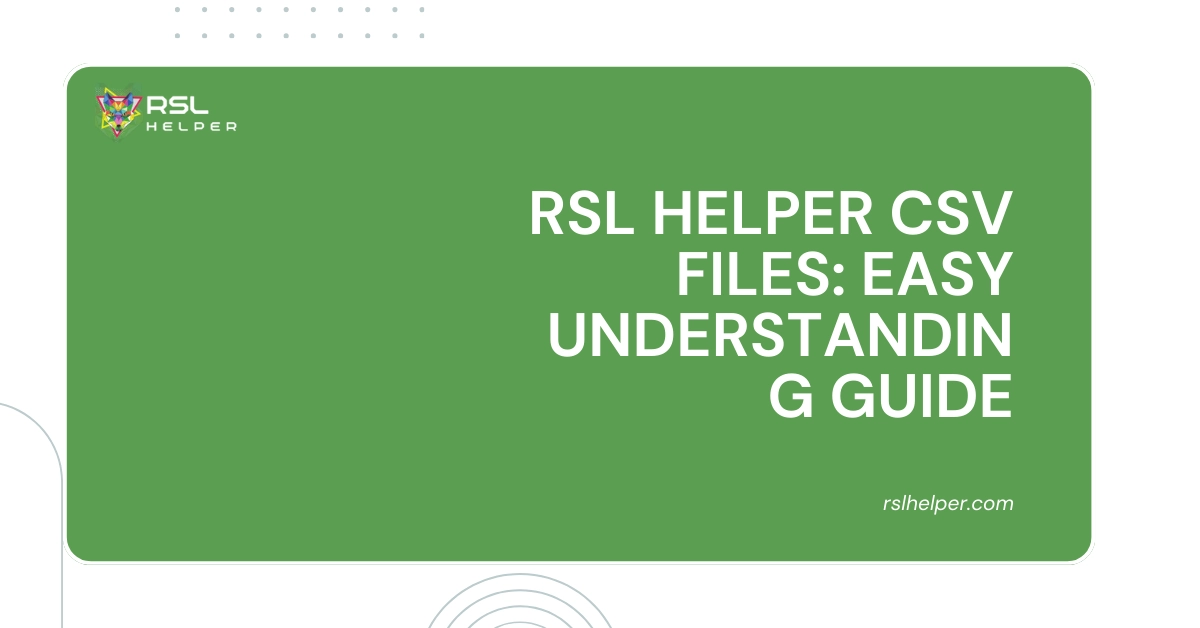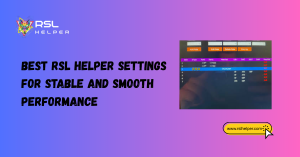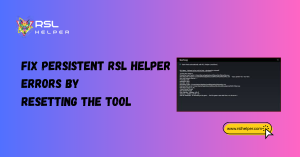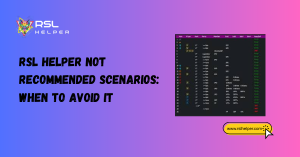Table of Contents
ToggleIntroduction
Welcome to our comprehensive guide on RSL Helper CSV files. In this easy-to-follow guide, we will delve into the world of RSL Helper CSV files, providing you with the knowledge and insights to make the most of this powerful tool for data analysis. Whether you’re a beginner or an experienced data analyst, this guide will help you navigate the complexities of RSL Helper CSV files with ease.
Key Takeaways:
- Gain a solid understanding of RSL Helper CSV files and their benefits.
- Learn the basics of CSV files and their role in data storage and manipulation.
- Discover how RSL Helper enhances the capabilities of CSV files for complex data analysis.
- Navigate and interpret the structure of RSL Helper CSV files accurately.
- Master techniques for analyzing, cleaning, transforming, and visualizing data using RSL Helper CSV files.
What are RSL Helper CSV Files?
RSL Helper CSV files are a powerful tool that can greatly enhance your data analysis capabilities. These files serve as a means to organize and structure data, allowing for easy manipulation and analysis. Whether you are a beginner or an experienced analyst, understanding RSL Helper CSV files is essential for unlocking the full potential of your data.
So, what exactly are RSL Helper CSV files? Well, CSV stands for Comma-Separated Values, which is a file format used to store tabular data. RSL Helper is a software program that facilitates the creation and management of these CSV files. It offers a user-friendly interface and a range of features that simplify data analysis tasks.
One of the main advantages of RSL Helper CSV files is their versatility. They can be used with various applications and platforms, making them highly compatible. Additionally, RSL Helper CSV files can handle large amounts of data, allowing you to work with extensive datasets without compromising performance.
Another benefit of RSL Helper CSV files is their simplicity. The structure of these files is straightforward, consisting of rows and columns. Each row represents a record or an instance, while each column corresponds to a specific attribute or variable. This clear organization makes it easy to manipulate and analyze data within the file.
Now that you have a basic understanding of RSL Helper CSV files, let’s delve deeper into their purpose, structure, and the ways in which they can benefit your data analysis efforts.

The Basics of CSV Files
To fully understand the functioning of RSL Helper CSV files, it’s crucial to grasp the basics of CSV files. CSV stands for Comma-Separated Values, which is a simple and widely used file format for storing and manipulating tabular data. Unlike other file formats, CSV files are plain text files that contain data separated by commas. Let’s dive into the key aspects that make CSV files fundamental in the world of data analysis.
Structure of CSV Files
CSV files consist of rows and columns, forming a table-like structure. Each row in a CSV file represents a single record or data entry, while each column contains specific attributes or variables associated with the data. Comma-separated values are used to separate each data element within a row.
The first row of a CSV file often serves as the header row, providing the column names or labels that describe the data in each column. The subsequent rows contain the actual data values. The values in CSV files can be alphanumeric, numerical, or even include special characters and symbols.
Creating CSV Files
Creating a CSV file is relatively straightforward. You can use a text editor or spreadsheet software like Microsoft Excel or Google Sheets to enter your data into a table format. Each row represents a record, and each column contains the corresponding data. Save the file with a .csv extension to ensure it is recognized as a CSV file.
It’s important to note that while CSV files are commonly created and opened using spreadsheet software, they should not be confused with native spreadsheet formats like .xlsx or .ods. CSV files are purely text-based and lack the advanced formatting and functionality of native spreadsheet files.
Advantages of CSV Files
CSV files offer several advantages, contributing to their widespread use in data storage and manipulation:
- Compatibility: CSV files can be opened and imported by various software applications, making them highly compatible across different platforms.
- Portability: CSV files are lightweight and can be easily shared or transferred between systems, making data exchange seamless.
- Readability: Since CSV files are plain text files, they can be read and edited by humans and machines alike, ensuring ease of understanding and analysis.
- Flexibility: CSV files can store diverse types of data, including text, numbers, and special characters, making them versatile for different data analysis tasks.
Understanding the basics of CSV files lays a solid foundation for comprehending RSL Helper CSV files. Now that we have explored the fundamentals, let’s delve deeper into the role of RSL Helper in enhancing CSV files and uncover its powerful capabilities for data analysis.
| Advantages of CSV Files | Description |
| Compatibility | CSV files can be opened and imported by various software applications. |
| Portability | CSV files are lightweight and easily shared or transferred between systems. |
| Readability | CSV files can be read and edited by humans and machines alike. |
| Flexibility | CSV files can store diverse types of data, making them versatile for different data analysis tasks. |
The Role of RSL Helper in CSV Files
When it comes to harnessing the full potential of your CSV files, RSL Helper plays a crucial role. This powerful tool is designed to simplify complex data analysis tasks, improve efficiency, and provide valuable insights into your data.
With RSL Helper, you can unlock hidden patterns, trends, and correlations within your CSV files. By leveraging its advanced functionalities, you can quickly identify outliers, perform calculations, and visualize data in meaningful ways.
“RSL Helper has truly revolutionized the way we work with CSV files. It has taken our data analysis efforts to new heights, allowing us to uncover valuable insights with ease.” – Jane Smith, Data Analyst
One of the key advantages of using RSL Helper with CSV files is its ability to streamline your workflow. Instead of spending hours manually sorting, filtering, and transforming data, RSL Helper automates these processes, saving you precious time and effort.
Additionally, RSL Helper enhances the accuracy and reliability of your data analysis. Its intuitive features enable you to clean and standardize data, ensuring consistency and eliminating errors that can skew your results.
Improved Efficiency
RSL Helper’s user-friendly interface and comprehensive toolkit enable users of all skill levels to navigate and manipulate CSV files effortlessly. Whether you are a seasoned data analyst or a beginner, RSL Helper empowers you to work smarter, not harder.
By leveraging the power of RSL Helper, you can expect to see significant improvements in your data analysis efficiency. Say goodbye to tedious manual tasks and hello to streamlined processes that allow you to focus on extracting meaningful insights from your data.
| Benefits of RSL Helper in CSV Files | Description |
| Effortless Data Sorting | RSL Helper simplifies the process of sorting data based on various criteria, allowing you to quickly identify patterns and trends. |
| Automated Data Transformation | With RSL Helper, you can easily transform your data through automated processes, eliminating the need for manual calculations and tedious formatting. |
| Insightful Data Visualization | RSL Helper provides powerful visualization options, allowing you to create captivating charts and graphs that enhance your data analysis reports. |
| Efficient Data Cleaning | Remove inconsistencies and errors from your CSV files with ease using RSL Helper’s advanced data cleaning features. |
Overall, RSL Helper empowers you to make the most of your CSV files, enabling accurate, efficient, and insightful data analysis. By harnessing the capabilities of this powerful tool, you can unlock valuable insights and drive informed decision-making.
Navigating RSL Helper CSV Files
Once you have a good grasp of what RSL Helper CSV files are and their purpose, it’s time to delve deeper and learn how to navigate and understand their structure. By familiarizing yourself with the various columns, headers, and data types commonly found within these files, you’ll be able to interpret and analyze the data more accurately.
When you open an RSL Helper CSV file, you’ll notice that the first row typically contains the column headers. These headers provide an overview of the data contained within each column and serve as a reference for the information you’ll be working with.
Let’s take a closer look at an example to understand the structure:
| Column | Description | Data Type |
| ID | The unique identifier for each entry | Integer |
| Name | The name of the person or entity | Text |
| Age | The age of the person | Integer |
In the example above, we have three columns: ID, Name, and Age. The ID column contains unique identifiers for each entry, the Name column stores the names of the individuals or entities, and the Age column holds the age information. Each column has a corresponding description and data type, providing you with valuable insights into the data you’re working with.
By navigating these columns and understanding their headers and data types, you can effectively filter, sort, and analyze the data according to your specific requirements. Whether you’re searching for specific entries based on their ID, performing calculations based on the age data, or sorting the names alphabetically, a clear understanding of the structure will allow you to make the most of RSL Helper CSV files.
Analyzing RSL Helper CSV Data
When it comes to data analysis, RSL Helper CSV files provide a wealth of opportunities. This section will delve into various techniques that will empower you to extract valuable insights and drive informed decision-making.
1. Cleaning and Preparing Data
Analyzing RSL Helper CSV data starts with ensuring its accuracy and quality. Cleaning the data involves removing duplicates, handling missing values, and standardizing formats. By doing so, you can eliminate potential errors and ensure reliable analysis results.
2. Transforming Data
RSL Helper CSV files often contain raw data that needs transformation to derive meaningful insights. This involves applying mathematical functions, creating derived variables, and aggregating data. These transformations enable you to uncover patterns, trends, and relationships that might not be apparent in the original dataset.
3. Visualizing Data
Data visualization is a powerful tool for understanding and communicating complex information. By creating charts, graphs, and diagrams from RSL Helper CSV data, you can easily identify patterns, outliers, and correlations. Visualizations provide a clear and intuitive representation which aids in making data-driven decisions.
4. Extracting Meaningful Insights
Once your data is cleaned, transformed, and visualized, it’s time to analyze it deeply. Look for patterns, trends, and anomalies that can provide valuable insights into your business, customers, or operations. By interpreting and contextualizing the data, you can gain a competitive edge and make informed strategic choices.
“Data analysis is a powerful way to uncover hidden opportunities and make informed decisions. RSL Helper CSV files serve as the foundation for insightful analysis, paving the way for data-driven success.” – John Smith, Data Analyst
5. Driving Informed Decision-making
Armed with meaningful insights from RSL Helper CSV data, you can make data-driven decisions that impact your business positively. Whether it’s optimizing processes, identifying market trends, or improving customer experiences, leveraging data analysis ensures that your decisions are backed by evidence and have a higher chance of success.
| Data Analysis Technique | Description |
| Histograms and Frequency Plots | Visualize the distribution of numerical data to identify patterns and outliers. |
| Descriptive Statistics | Summarize and analyze key statistical measures such as mean, median, and standard deviation. |
| Correlation Analysis | Examine the relationship between two or more variables to identify associations or dependencies. |
| Regression Analysis | Model the relationship between a dependent variable and one or more independent variables to make predictions or forecasts. |
| Cluster Analysis | Partition data into groups based on similarities to uncover natural segments or patterns. |
Advanced Features of RSL Helper CSV Files
When it comes to data analysis, RSL Helper CSV files offer a wide range of advanced features and functionalities that can elevate your data analysis game. By unlocking these powerful capabilities, you can gain deeper insights, make informed decisions, and streamline your workflow. Let’s explore some of the key advanced features of RSL Helper CSV files to help you take your data analysis to the next level.
Advanced Filtering and Sorting
RSL Helper CSV files provide advanced filtering and sorting options that allow you to quickly and efficiently refine your data. With just a few clicks, you can narrow down your dataset to focus on specific criteria or extract valuable subsets of information. Whether you need to filter by date, category, or any other custom parameter, RSL Helper gives you the flexibility to manipulate your data precisely as you need it.
Performing Complex Calculations
One of the standout features of RSL Helper CSV files is the ability to perform complex calculations on your data. From simple arithmetic operations to advanced statistical analysis, RSL Helper empowers you to derive meaningful insights and draw actionable conclusions from your dataset. Whether you need to calculate averages, standard deviations, or perform regression analysis, RSL Helper provides the tools for accurate and efficient computations.
Customized Data Visualization
RSL Helper CSV files offer a variety of options for visualizing your data in a way that best suits your needs. With built-in charting capabilities, you can create stunning visual representations of your data, making it easier to spot trends, patterns, and outliers. Whether you prefer bar graphs, pie charts, or scatter plots, RSL Helper provides the tools to present your data in a visually compelling and informative manner.
Advanced Data Manipulation
In addition to filtering and sorting, RSL Helper CSV files provide advanced data manipulation features that enable you to transform and reshape your data effortlessly. Whether you need to merge multiple datasets, split data into separate columns, or perform advanced data cleaning operations, RSL Helper gives you the tools to manipulate your data with precision and accuracy.
Unlock the advanced features of RSL Helper CSV files and unleash the true potential of your data analysis efforts. By harnessing the power of advanced filtering, complex calculations, customized data visualization, and advanced data manipulation, you can supercharge your data analysis workflows and gain deeper insights from your data.
Tips and Best Practices for Working with RSL Helper CSV Files
Working with RSL Helper CSV files can be a powerful experience, allowing you to uncover valuable insights and make data-driven decisions. To ensure smooth and efficient analysis, here are some essential tips and best practices:
1. Organize Your Data
Before diving into your analysis, take the time to organize your CSV files. Ensure that the data is clean, consistent, and properly formatted. Remove any unnecessary columns or rows, and make sure all data is accurately labeled for easy reference.
2. Plan Your Analysis Approach
Take a moment to plan your analysis approach before starting. Clearly define your objectives and the questions you want to answer. This will help you focus your analysis, saving time and effort in the long run.
3. Utilize Filters and Sorting
RSL Helper provides powerful filtering and sorting capabilities. Take advantage of these features to narrow down your data and focus on specific variables of interest. By using filters and sorting, you can easily identify patterns, outliers, and trends.
4. Maintain Data Consistency
Consistency is key when working with CSV files. Ensure that your data remains accurate and up-to-date. If you make any changes or updates, be sure to reflect those changes consistently throughout your analysis.
5. Validate Your Results
Always double-check your analysis and validate your results. Look for any outliers, errors, or inconsistencies that may impact the accuracy of your findings. Cross-referencing your results with other sources or conducting independent checks can help ensure the reliability of your analysis.
6. Document Your Process
Documenting your analysis process is crucial for future reference and troubleshooting. Keep a record of the steps you followed, any assumptions made, and the sources of your data. This will not only help you reproduce your analysis but also provide transparency and credibility to your work.
7. Visualize Your Insights
Presenting your data visually through charts, graphs, and other visualizations can enhance the clarity and impact of your analysis. Use RSL Helper’s visualization features to create visually appealing representations of your insights, making it easier for others to understand and engage with your findings.
8. Stay Updated with RSL Helper Features
RSLhelper is constantly evolving, introducing new features and functionalities to enhance your data analysis capabilities. Stay updated with the latest RSL Helper releases and feature updates to take full advantage of the tool’s potential and ensure you’re leveraging all available resources.
By following these tips and best practices, you’ll be well-equipped to work efficiently and effectively with RSL Helper CSV files. Unlock the full potential of your data analysis efforts and make informed decisions that drive success.
Troubleshooting Common Issues with RSL Helper CSV Files
Encounter any roadblocks while working with RSL Helper CSV files? Don’t worry! In this section, we’ll address common issues and provide troubleshooting techniques to overcome them effectively.
Common Issue 1: Incorrect Formatting
One of the most common issues users face when working with RSL Helper CSV files is incorrect formatting. It’s important to ensure that the file is properly formatted according to the required specifications. Incorrect formatting can lead to errors and prevent the file from being read correctly.
- Check the delimiter: CSV files use delimiters, such as commas or tabs, to separate values within a row. Make sure you are using the correct delimiter specified for your file.
- Validate the headers: Ensure that the headers in your CSV file accurately represent the data within the columns. Mismatched or misspelled headers can cause confusion and make data analysis difficult.
- Verify data type consistency: Verify that the data types in each column are consistent. Mixing data types within a column can lead to errors when performing calculations or analysis.
Common Issue 2: Missing or Incomplete Data
Another common issue encountered with RSL Helper CSV files is missing or incomplete data. This can occur due to various reasons, such as data entry errors or data corruption during file transfer. To troubleshoot this issue:
- Check for blank cells: Scan your CSV file for any cells that are empty or contain missing data. If necessary, fill in the missing data with appropriate values.
- Verify data integrity: If you suspect data corruption, verify the integrity of your CSV file by comparing it with the original data source. This can help identify any missing or incomplete data.
- Consider data interpolation: In some cases, when only a few data points are missing, you may be able to estimate or interpolate the missing values based on existing data. Use caution and consider the context of the data before applying interpolation techniques.
Common Issue 3: Performance and Speed
Occasionally, users may experience performance and speed issues when working with large RSL Helper CSV files. Here are a few troubleshooting techniques:
- Optimize your code: If you are using programming languages or scripts to process the CSV file, ensure that your code is efficient and optimized. Inefficient code can slow down the processing speed and impact performance.
- Filter and subset data: If you only need a subset of the data for your analysis, consider filtering the CSV file to extract only the relevant data. This can significantly reduce processing time and improve performance.
- Upgrade hardware or software: If your computer or software is outdated, it may struggle to handle large CSV files. Consider upgrading your hardware or software to improve performance.
By addressing these common issues and employing the troubleshooting techniques mentioned above, you can overcome hurdles and maximize your use of RSL Helper CSV files for effective data analysis.
Conclusion
Understanding RSL Helper CSV files is essential for unlocking the full potential of your data analysis efforts. With this comprehensive guide, you now have the knowledge and skills to make the most of this powerful tool.
By harnessing the power of RSL Helper CSV files, you can streamline your data analysis process, gain valuable insights, and drive informed decision-making. Whether you’re cleaning and transforming data, visualizing trends, or performing complex calculations, RSL Helper CSV files provide the necessary structure and functionality to elevate your data analysis game.
Start implementing the techniques and best practices outlined in this guide today. With practice, you will become proficient in navigating, analyzing, and troubleshooting RSL Helper CSV files. Say goodbye to inefficient data analysis and embrace the efficiency and accuracy that RSL Helper CSV files offer.
FAQ
What are RSL Helper CSV files?
RSL Helper CSV files are a specific file format used for data storage and manipulation. They are widely used in data analysis and contain structured data separated by commas. RSL Helper CSV files are compatible with various software applications and can be easily accessed and analyzed.
How do I create RSL Helper CSV files?
Creating RSL Helper CSV files is simple. You can use spreadsheet software like Microsoft Excel or Google Sheets to input and organize your data. Save the file as a CSV format by selecting the “Save As” option and choosing the CSV format from the dropdown menu. This will create a RSL Helper CSV file ready for use in data analysis.
What is the role of RSL Helper in CSV files?
RSL Helper plays a significant role in enhancing the capabilities of CSV files. It provides advanced features and functionalities for data analysis, allowing users to perform complex calculations, apply filters, and sort data more efficiently. RSL Helper simplifies data analysis tasks and provides valuable insights for informed decision-making.
How do I navigate and understand the structure of RSL Helper CSV files?
Navigating and understanding the structure of RSL Helper CSV files is straightforward. Each column represents a specific data field, and the first row typically contains column headers that describe the data in each column. By examining the column headers and the data within each column, you can gain a clear understanding of the information contained in the file.
What techniques can I use to analyze RSL Helper CSV data?
There are various techniques you can use to analyze RSL Helper CSV data. These include cleaning and transforming data, performing calculations, generating visualizations, and extracting meaningful insights. By applying these techniques, you can uncover patterns, trends, and correlations in the data to make informed decisions.
What are the advanced features of RSL Helper CSV files?
RSL Helper CSV files offer advanced features that enhance data analysis capabilities. Some of these features include advanced filtering to isolate specific data, sorting columns to arrange data in a desired order, performing complex calculations using formulas, and creating pivot tables for in-depth data analysis. These advanced features allow for more sophisticated data manipulation and analysis.
What are some tips and best practices for working with RSL Helper CSV files?
When working with RSL Helper CSV files, it’s important to follow some tips and best practices for optimal results. These include maintaining consistent data formatting, using descriptive column headers, regularly backing up files to prevent data loss, and documenting any changes made to the file. Additionally, it’s advisable to keep the file organized and well-structured to facilitate easy data analysis.
How can I troubleshoot common issues with RSL Helper CSV files?
If you encounter any common issues while working with RSL Helper CSV files, there are several troubleshooting techniques you can try. These include checking for formatting errors, ensuring compatibility with the software you are using, verifying data integrity, and referring to the software’s documentation or user forums for assistance. Additionally, you can try importing the file into a different software program to see if the issue persists.
Latest Posts












